This ancient grain is making a comeback and now you have a no-fail white spelt bread recipe at your fingertips. Learn all about this high-fiber grain, including how to bake spelt bread at home.
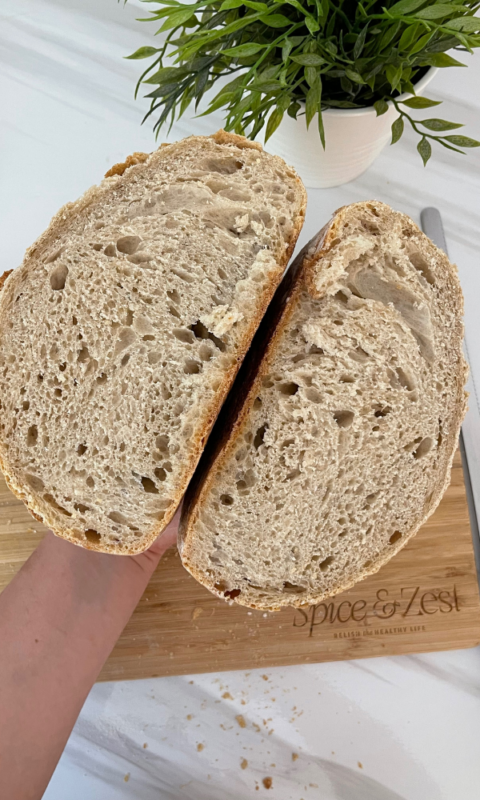
When we started our health journey, I was looking for a better alternative to white bread flour. My husband is known for his delicious sandwiches, and he was not ready to give it up. I started experimenting with spelt flour after I heard about how it was supposedly so gentle on people’s stomachs. But the bread didn’t turn out the best, and I found out that spelt actually didn’t agree with my family.
So, I continued to search for a healthier alternative until I stumbled upon sourdough. All of a sudden, we enjoyed delicious sandwiches again without upset stomachs.
Are you curious about baking with spelt? Then this article is for you!
In this guide, I’ll answer all your questions about spelt bread (and I’ve received a lot). Is spelt healthier than wheat? Is it gluten-free? How do you bake with it? If you have questions about baking with spelt flour, then keep reading. This guide is for you.
What Is Spelt Flour?
Spelt flour is a type of flour derived from the ancient grain spelt. It fell out of favor in the 19th century as modern wheat varieties took over but has seen a resurgence in popularity in recent years due to its nutritional benefits and unique flavor.
The grain has a tough outer husk, which protects the nutrients in the grain, making spelt a highly nutritious flour choice. It’s rich in dietary fiber, protein, and a range of essential minerals such as manganese, magnesium, phosphorus, and zinc. It also contains a good amount of B vitamins.
Spelt flour comes in two forms – white and whole spelt.
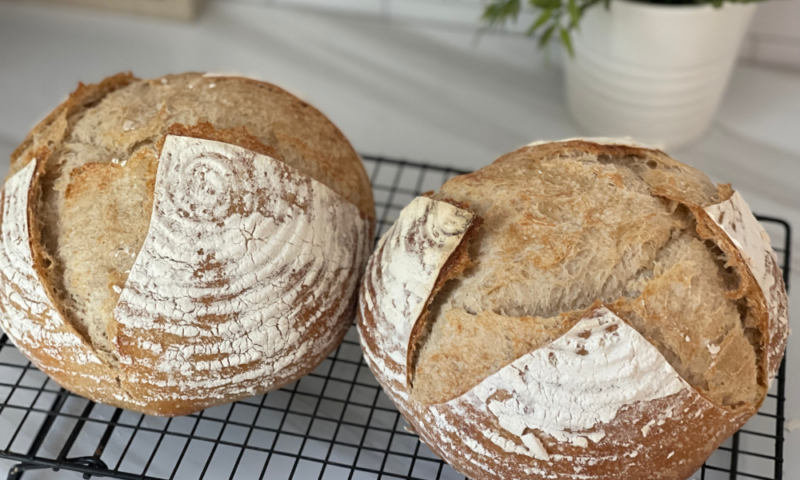
What Is The Difference Between White and Whole Spelt?
There are a few very important differences between white and whole spelt flour, so let’s look a bit closer at them.
White Spelt Flour
White spelt flour is made by removing the bran and germ, leaving just the starchy endosperm. This results in a lighter flour that is easier to work with, especially in recipes that call for a tender crumb.
While it’s easier to work with than whole spelt flour, it still poses a slightly greater challenge than traditional wheat flour due to the different gluten structure and absorption properties. It’s also important to note that white spelt flour, though still nutritious, contain less fiber and fewer nutrients than its whole spelt counterpart.
Whole Spelt Flour
Whole spelt flour is made by grinding the entire spelt grain — including the bran, germ, and endosperm. The presence of the bran and germ gives this flour a darker color and results in a denser, more fiber-rich baked product.
Is Spelt Gluten-Free
One of the biggest misconceptions is that spelt is gluten-free. It has this reputation because spelt is known for being easier for gluten-sensitive people to digest.
But it’s important to note that spelt flour does contain gluten. It is not suitable for those with celiac disease or a gluten intolerance. However, some people who have a sensitivity to modern wheat find they can tolerate spelt.
If you’re sensitive to gluten, you don’t have to exclusively use spelt. Even though it has lower gluten than wheat flour, making sourdough in general (even with bread flour) is just as gentle on your gut. You don’t have to use spelt to get those digestion benefits.
Once you have the starter and make sourdough, your body will experience the same benefits whether you use spelt or wheat flour. Remember, the fermentation process breaks down the gluten – whether you use spelt or wheat.
That being said, there are some health benefits of spelt that wheat doesn’t have.
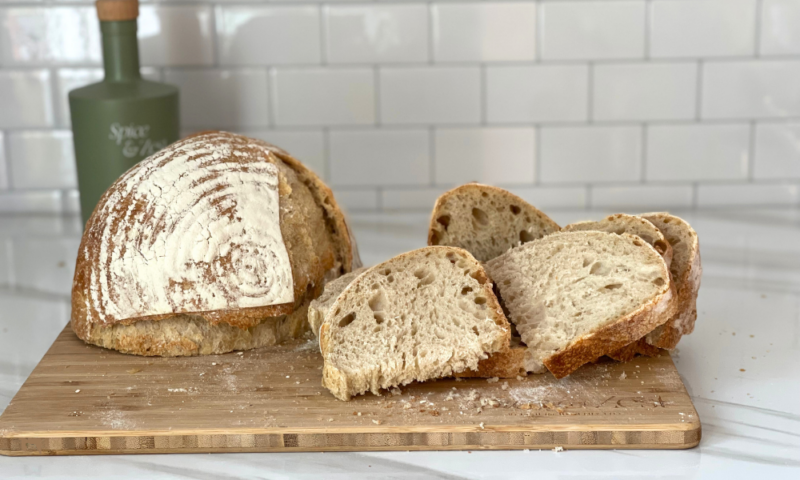
Spelt Health Benefits
One of the biggest reasons it’s becoming so popular is because spelt is so good for you.
This ancient grain has a lot to brag about! Here are just a few of the biggest nutritional benefits of spelt:
- Non-GMO: Since this is an ancient grain, it hasn’t been genetically modified.
- High-Fiber: Spelt has 11 grams of fiber per 100 grams of flour
- High Protein Content: Spelt has 14.6 grams of protein per 100 grams
- Excellent Source of Iron: This is really good for energy production and immune system support.
Spelt also contains the following essential nutrients:
- Magnesium
- Potassium
- B Vitamins
- Vitamin E
- Amino Acids
Baking Challenges
As good as spelt is for you, it poses some challenges when you bake with it.
The most challenging thing about spelt is that it behaves differently regarding hydration. In other words, it absorbs less water than wheat flour. So, you’ll have to adjust the water content in your recipe if you’re using spelt instead of bread flour.
When I bake spelt bread, I usually add less starter (compared to my basic bread recipe). You don’t need as much starter in spelt dough because spelt makes the starter grow faster.
Don’t be disheartened if your first few attempts aren’t perfect – baking with spelt often calls for a bit of practice and trial and error. But trust me, the results are worth the effort!
Don’t Skip The Stretch and Fold
When I make basic sourdough, I usually skip the stretch and fold step, but when you bake with spelt, this step is very important.
Spelt is more delicate, so you have to work the gluten in the dough. Stretching and folding it is the best way to incorporate it.
Without further ado, let’s dive into the recipe!
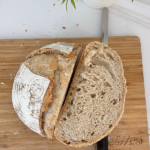
White Spelt Sourdough Bread Recipe
Servings
Equipment
- Large Mixing Bowl
- Towel or something to cover the bowl with
- Dutch Oven
Ingredients
- 90 grams Active Sourdough Starter
- 305 grams Water
- 500 grams White Spelt Flour
- 7 grams Salt
Instructions
Preparing the Dough
- In a large bowl combine the starter, flour, and water leaving 30g out for later.
- Mix until well incorporated.
Autolyse
- Cover the bowl and leave to rest for 60-90 minutes.
- After you let the dough rest add the salt with 30g water and knead very well until salt and water is combined into dough.
Bulk Rise (aka Bulk Ferment)
- Cover and set the bowl in a warm area (75-80 degrees) for 3 to 4 hours.
- During the bulk rise, perform stretch and folds every 30-60 minutes. Towards the last hour fold more gently to avoid pressing gas out of the dough.
Bench Rest
- Scoop the dough onto the countertop.
- Lightly flour the top of the dough. Very gently turn over the dough so the floured side is face down, and fold the dough on all 4 ends, gently shape into a round boule.
- Leave to rest for 20 minutes. The edges should be round and thick (it's ok if it flattens a little) but they should not taper off. If they do taper or flatten off, reshape, and let sit for another 20 minutes (this is like doing another set of folds during the bulk rise).
Shaping
- Sprinkle a lined bowl or banneton with 50/50 flour blend of rice and white wheat flour
- Fold bottom third up, right side third over, left side third over, top third over and then roll the entire loaf over and gently pull toward you letting tension form the loaf (at this point you can make the top of your dough a bit damp and roll in oats.
- Place the shaped bread in the prepared bowl.
- Let rise for 3 to 4 hours at room temp or place in refrigerator for 8-24 hours (known as ‘retard’).
Baking
- Place your Dutch oven in the oven and preheat the oven to 500 degrees.
- Gently place the dough into the Dutch oven and score the top of the bread.
- Bake at 500 degrees covered for 20 minutes.
- Remove lid, lower temperature to 450 and continue to bake for an additional 20 – 30 minutes until crust is a rich dark amber color.
- Let it cool on wire rack.


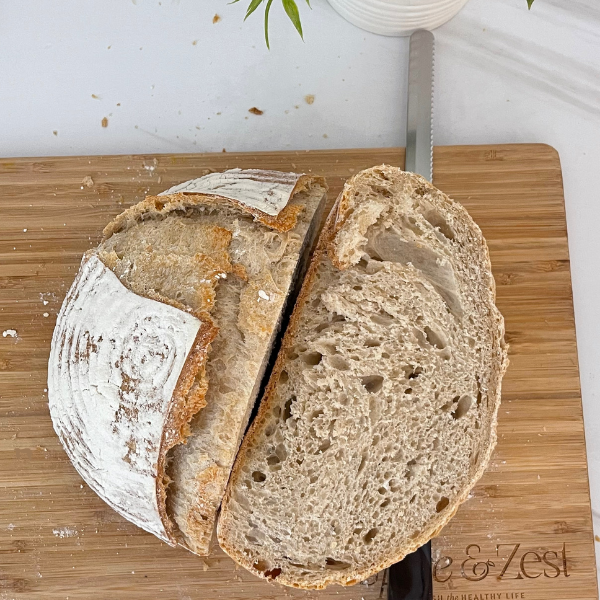
 Basic Sourdough Recipe
Basic Sourdough Recipe
Thanks so much! I’d love to try it. Which spelt flour do you use?
Thanks
Hi Esther, Any brand should work for this recipe as long as it is white spelt..
Thank you for all your help. Your recipe was easy to follow and it tastes amazing!
Thank you so much for your wonderful feedback! 🙂
Hi, I followed the recipe for white spelt and it worked very well. Thanks very much !! Quick question, I’m looking to try a wholemeal spelt loaf next…can you recommend any changes id need to make to your recipe to make it work? Thanks
Hi!
I’m so happy to hear the recipe worked well for you—thanks for trying it out! For a wholemeal spelt loaf, you’ll need to adjust a few things since it absorbs more water than white spelt. I recommend increasing the hydration slightly and keeping an eye on the fermenting time, as wholemeal spelt tends to ferment faster. You might also find it helpful to bake it in a loaf pan for structure and better results.
I want to try this recipe now that I am comfortable making sourdough bread. Does my starter need to be a spelt starter?
Hi Miriam, You can use any starter to make this recipe, as a matter of fact I use my wheat starter with great success.
Great! I cant wait to see how it works out. Thanks for your quick response!!
I just made a load of spelt sourdough for my daughter’s family I see you wrote in the recipe to keep it out 4 hours OR in fridge Can I bake it after 4 hours w/o refrigeration at all? And can I refrigerate it if it’s out like 2 hours? And bake tomorrow?
Hi, how do I feed my spelt starter? How much water to how much spelt flour?
You don’t need to have a spelt starter for this recipe, you can use your starter made of bread flour.
For the past few weeks I have been making this recipe and it’s a hit! My son said asked me to make the sourdough bread this way he likes it so much better!!! As soon as I can work up the guts I will try the multi grain recipe.
Hi Miriam,
I am so happy to hear your family is enjoying it! 🙂 Thank you so much for this feedback!
Hi. I took your course and my breads have been coming out and tasting amazing!
Now I’m on to trying spelt.. if I want to make spelt rolls, are there any specific instructions?
What’s the baking temp and time for rolls?
That’s amazing thanks for sharing, love hearing that your breads are turning out amazing!
You can definitely use this recipe for spelt rolls. Bake them at 375°F for about 35-45 minutes, depending on their size.
Hi,
After letting it rise in the fridge does it need to come to room temp before baking?
No. you can bake it as soon as you take it out of the fridge, as a matter of fact I prefer it this way since it’s easier to score when the dough is cold.
Hi, thanks for this recipe!
How would you adjust the hydration for 1/3 whole spelt flour 2/3 white spelt flour?
Hi Shaindee,
I am not sure about that as I haven’t tried it.. My rule of thumb is when playing around with different flours is to start with a little less water and add as you knead if you feel it needs it….
Hi, I love baking and any thing to do with the kitchen! No recipe scares me. I tried sour dough a couple of times but never got it right. I watched your videos on kosher.com and decided to go give it another chance. Oh my gosh!! They came out heaven beyond!! Thanks!!
Thank you so much for your wonderful feedback! 😊 I’m thrilled to hear that you gave sourdough another try and had such amazing results. Enjoy baking and savoring your delicious bread!
How can I make this recipe into rolls?
Hi Chaya,
I never tried it with this recipe but I don’t see why not… If you try it let us know.
Hi, I would like to try this recipe as a rolls. How would I divide the dough?
If I want to take Challah, how many times would I multiply the recipe?
For rolls, it depends on the size you want. A nice size is usually about 135-150g per roll.
As for taking Challah, there are different opinions on the amount of flour required for hafrashas Challah. It’s best to check with your Rabbi to confirm the required amount of flour and once you know, you can multiply the recipe accordingly.
HI,
I see that in this recipe as opposed to your other recipe it just says “sourdough starter” vs. “active sourdough starter”. Does that mean that I shouldn’t feed my starter so that its active before making the dough?
Please explain, thank you!
Hi Chana,
Thank you for bringing this to our attention. This was a error, you need active starter.
When doing the recipe 3x, I added 21g salt and 90g water later but found it very hard to incorporate the water.. should I rather just add less water?
Hi Suzy,
Yes when making 3x the recipe you only need to reserve 30g for the salt. Adding a little water with the salt helps dissolve the salt and makes it easier to incorporate.
Should I feed the sour dough with spelt flour too
It is not necessary. When baking spelt bread you can use your regular starter you have.
Hi Sarah
I’d like to try baking this bread in a loaf pan.
What adjustments do i have to do before and during baking (times, temperatures).
Thanks
You can bake it on 375°F for approx 50-60 min
You say to In a large bowl combine the starter, flour, and water leaving 30g out for later.
I take 30g of the combined mixture out? And what is that used for? Do I just store that in the fridge?
Hi Rivky, leave out 30g of the water, in the next step it says to use it with the salt to help dissolve the salt when added to the dough…
Hi, would you have a method to bake this in a bread machine?
Hi, I never attempted this in a bread machine, but if you try it do let me know. 🙂
Hello,
When you bulk ferment the dough for 3-4 hrs, do you go my time or the amount the dough has risen? How much should the dough rise in bulk fermentation?
After shaping, if you put it in the fridge for cold retard, how much does it rise there?
It’s best to focus on the dough’s appearance rather than strictly to the clock; timeframes are just rough estimates since the ambient temperature can significantly affect the rise time. During bulk fermentation, watch for the dough to almost double in size and become full of air pockets, which typically takes about 3-4 hours. However, adjust based on how your dough is developing.
After shaping, when you place the dough in a cold spot in the fridge, it will continue to rise, albeit much more slowly. You won’t see a huge increase in volume, but it should rise slightly.
Thank you for this great recipe!
This is the most delicious sourdough bread I’ve made/ tasted so far!
Thank you Noa for this feedback I really appreciate it!
Can i double the recipe?
Hi Yvette,
Sure! On the recipe card there’s a feature you can click x2 or x3 and it will automatically update the amount for you. 🙂
Hi!
I’m new to sourdough…can you explain step number 2 in shaping? ive only ever naturally shaped it into a ball…I don’t understand what folding the bottom third up, right side third over, left side third over, top third over means
Of course! You’re basically folding the dough like an envelope to build strength and shape. First, fold the bottom third of the dough up towards the center. Then fold the right third over to the center, then the left third over that. Finally, fold the top third down. Once folded, flip it over so the seam is underneath, and gently tighten it into a round shape. This helps create surface tension so it holds its shape during proofing and baking.
hi, I wrote a while ago, but I never received a reply I was wondering how to convert this recipe into small rolls. thank you so much.
Sorry I missed your message earlier! You can shape the dough into small rolls right after the bulk fermentation. Divide into equal portions (about 100-120g each works well), shape into rolls, and let them proof until ready to bake. Baking time will be shorter — usually around 20–25 minutes depending on size.
Hi can you use whole spelt flour or specifically needs to be white spelt flour?
Hi Simi, If you use whole spelt flour you’ll need to adjust the water content. Just a heads-up, it may not hold its shape as well due to the higher fiber content. I usually bake whole spelt bread in a loaf pan. You can try my multigrain recipe which includes 50% whole grain spelt.
if i put in fridge so i wait till rises or comes to room temp before baking in the morning?
It will rise a bit in the fridge overnight, so don’t worry! I usually bake it straight out of the fridge—it’s easier to score when the dough is cold. However, if you feel it needs more rise time, you can let it sit at room temperature for 2-3 hours before baking. Either way, it should turn out great. Let me know how it works out for you! 😊
Thanks, made this last week was absolutely delicious! My family loved it better then my usual recipe. Can I bulk ferment in the fridge after 2 hours?
So happy to hear your family loved it! Yes — after about 2 hours at room temp, you can absolutely move the dough to the fridge to finish bulk fermentation. Just make sure the dough has started rising a bit before chilling, and allow extra time for it to finish rising fully in the fridge.
How do I make this recipe in a sweeter version? Do you have a spelt sourdough recipe with honey in it? Thanks!
I currently don’t have a recipe with honey on the website, but it’s something I’m working on with whole spelt—so stay tuned! That recipe will be coming soon.
Hi!
I have been trying to make this sourdough recipe for the past couple of weeks, but every time I either overproof or underproof. This past try it was fully risen but still extremely sticky. Do you have any tips for me to fix this issue? Thank you!
Hi Ahuva, Are you using white spelt or whole spelt flour?
white spelt
Hi I have the same issue and I’m also using white spelt . Any tips?
Try cutting back about 10g of water in your recipe. Different brands and types of flour absorb water differently, so a slightly lower hydration level might make a big difference.
Avoid keeping your dough in a very warm spot, as higher temperatures can make the dough stickier and harder to handle.
Make sure your starter is at its peak activity when you use it (bubbly and doubled, not deflated). An active starter helps create stronger dough structure.
Let me know if any of these tips helped. 🙂
I tried this last night in the 15 -17 degrees in my house,
Bf 7am to 7pm, it just wouldn’t hold any shape when pre-shaping,
Any tips? Less water?
At 15–17°C, a 12-hour bulk is likely too long — the dough can over-ferment and lose structure, which is why it wouldn’t hold shape. My recipe calls for about 3–4 hours at room temp; much longer can weaken the gluten. Shortening the bulk time should help. You may not need to reduce water — just adjust fermentation time for your temp.
I don’t know if you mention this anywhere but it is something i have noticed and it works. Sometimes I feed my starter in order to begin my sour dough but something comes up and i won’t be able to make my dough that evening. I put the doubled or almost doubled starter into the fridge and use it the next day – it continues growing slowly in the fridge and I don’t waste a good starter. I have done this a number of times and it works well! Is this something you have come across in your experience?
Yes! You’re exactly right — that’s a great tip and something I do as well. Once your starter is active and close to fully doubled, you can refrigerate it and use it the next day without any issue. It will continue to slowly ferment in the fridge and stay strong for baking. Just make sure to refrigerate it before it becomes fully active and starts to deflate — that way it holds its strength and you don’t lose the peak activity. Thanks for sharing!
Hi, I am wondering about the rolls that people are mentioning. I have 2 Dutch ovens that could maybe hold 2 rolls each although I’m skeptical about whether they would attach to each other. Is there a more practical way to bake these rolls?
Youu can definitely make them as rolls!
After shaping, divide your dough into smaller portions (about 80–100g each) and shape into tight balls. Place the rolls on a parchment-lined sheet tray, leaving a bit of space between each one. Cover and let them proof as usual.
When ready to bake, preheat your oven to 450°F (232°C). Place the tray of rolls into the oven and add ice cubes to a lower tray for steam, just like you’ve been doing. Bake for 18–22 minutes, until golden and baked through.